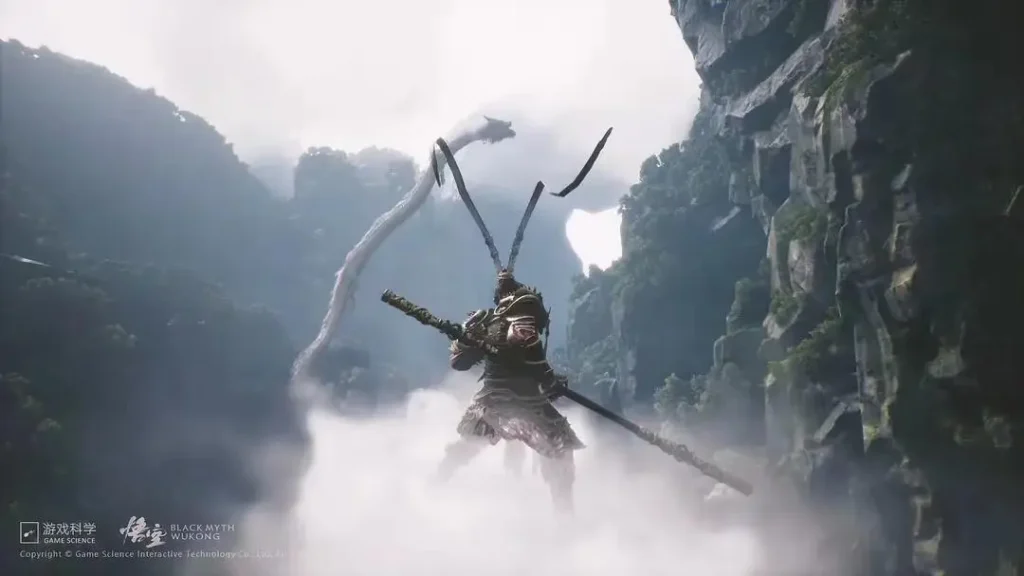
An Analysis of Buddhist Philosophy in “Black Myth: Wukong”
The story of “Black Myth: Wukong” begins after the successful completion of the mission to obtain the scriptures in the Journey to the West. At the beginning of the game, Sun Wukong, who has already been titled “The Victorious Fighting Buddha,” decides to give up his position and retire to Flower Fruit Mountain.

However, the Heavenly Court sends Erlang Shen to lead an army to subdue the mountain and bring Wukong back, leading to his eventual defeat and death. Over generations, countless monkeys have attempted to revive Sun Wukong. Players take on the role of one of these monkeys, defeating various monsters from “Journey to the West” to prove themselves worthy of inheriting the title of “Great Sage.” They enter Wukong’s memories, overcome his lingering consciousness and body, and eventually become “Sun Wukong.”
As a commercial game, “Black Myth: Wukong” features a significant amount of original content. Many aspects of the story are open to interpretation, but it is clear that the game is deeply rooted in Buddhist culture. Today, we will discuss this popular game from the perspective of core Buddhist principles.
What is the Journey to the West?
In the game, players collect the “Six Roots” left by the Great Sage. These “Six Roots” are named “Eye Joy, Ear Anger, Nose Love, Tongue Thought, Body Sorrow, and Mind Desire” (from Chapter 16 of “Journey to the West”). These peculiar names are derived from the six senses and their corresponding objects in Buddhism: eye and visible objects, ear and sound, nose and smell, tongue and taste, body and touch, mind and mental objects. The game’s design is closely related to Buddhist teachings on these concepts.
There is also a hidden quest line to collect the “Five Aggregates.” The concept of “Five Aggregates” is an abstract way of categorizing all phenomena in the world. This concept is deeply rooted in Buddhist philosophy and reflects a more profound understanding of the game’s narrative.
How does “Black Myth: Wukong” Retrace the Journey to Obtain the Scriptures?
Understanding the true essence of the Journey to the West, let’s reexamine the game’s plot with a Buddhist perspective.
- The first chapter:”Burning Black Clouds,” draws from the story of Jinchi Elder from “Journey to the West.” The elder’s desire for a robe given by Tang Sanzang leads to his downfall. In the game, defeating these monsters grants the “Eye Root – Joy,” reflecting how attachment arises from sensory experiences.
- The second chapter, “Wind Rises at Dusk,” introduces an original storyline about the Sand Kingdom. The king’s rejection of Buddhist teachings results in chaos. Defeating these monsters grants the “Ear Root – Anger,” symbolizing how attachment arises from auditory experiences.
- The third chapter, “Night Dew Rises,” is inspired by Little Thunder Monastery in “Journey to the West.” The Yellow Brow Monster’s pursuit of pleasure reflects attachment arising from olfactory experiences. Defeating these monsters grants the “Nose Root – Love.”
- The fourth chapter, “Curved Purple Mandarin Ducks,” tells an original love story between Zhu Bajie and a spider spirit. Zhu Bajie’s entanglement with his past reflects attachment arising from gustatory experiences. Defeating these monsters grants the “Tongue Root – Thought.”
- The fifth chapter, “Red Dust at Sunset,” draws from the story of Flaming Mountain in “Journey to the West.” The Bull Demon King’s attachment to his past reflects attachment arising from tactile experiences. Defeating these monsters grants the “Body Root – Sorrow.”
Finally, in the sixth chapter, players return to Flower Fruit Mountain and enter Sun Wukong’s memory space. The images of defeated monsters reappear within this space. This reflects the Buddhist teaching that all consciousness is fleeting and interconnected.
How Many Rounds Must One Walk on the Journey to Obtain the Scriptures?
The game allows players to restart after defeating the final boss. If players haven’t found all hidden maps, they cannot unlock the true ending and must start over. This design reflects Buddhist concepts of impermanence and rebirth.
If players find all hidden maps and complete hidden tasks, they unlock the true ending and gain access to Sun Wukong’s memories for a final battle using his original form. This reflects Buddhist teachings on karma and fruition.
In conclusion, “Black Myth: Wukong” presents a profound journey through Buddhist philosophy. The game’s narrative and mechanics are deeply intertwined with Buddhist concepts such as impermanence, attachment, and rebirth. By experiencing this journey alongside the game’s protagonist, players gain insight into the cyclical nature of existence and the path to liberation.
In summary, “Black Myth: Wukong” offers a compelling exploration of Buddhist philosophy within a captivating gaming experience. It provides players with an opportunity to delve into profound teachings while embarking on an epic adventure through ancient mythology.